 Spring 框架 - AOP代理实现
Spring 框架 - AOP代理实现
# Spring 框架 - AOP代理实现
# 代理的创建
# 引入
前文主要Spring AOP原理解析的切面实现过程(加载配置,将切面类的所有切面方法根据使用的注解生成对应Advice,并将Advice连同切入点匹配器和切面类等信息一并封装到Advisor)。
同时我们也总结了Spring AOP初始化的过程,具体如下:
由IOC Bean加载方法栈中找到parseCustomElement方法,找到parse
aop:aspectj-autoproxy的handler(org.springframework.aop.config.AopNamespaceHandler)AopNamespaceHandler注册了
<aop:aspectj-autoproxy/>的解析类是AspectJAutoProxyBeanDefinitionParserAspectJAutoProxyBeanDefinitionParser的parse 方法 通过AspectJAwareAdvisorAutoProxyCreator类去创建
AspectJAwareAdvisorAutoProxyCreator
实现了两类接口,BeanFactoryAware和BeanPostProcessor;根据Bean生命周期方法找到两个核心方法:postProcessBeforeInstantiation和postProcessAfterInitialization
- postProcessBeforeInstantiation:主要是处理使用了@Aspect注解的切面类,然后将切面类的所有切面方法根据使用的注解生成对应Advice,并将Advice连同切入点匹配器和切面类等信息一并封装到Advisor
- postProcessAfterInitialization:主要负责将Advisor注入到合适的位置,创建代理(cglib或jdk),为后面给代理进行增强实现做准备。
本文接着介绍postProcessAfterInitialization的方法,即Spring AOP的代理(cglib或jdk)的创建过程。
创建代理的方法是postProcessAfterInitialization:如果bean被子类标识为代理,则使用配置的拦截器创建一个代理
/**
* Create a proxy with the configured interceptors if the bean is
* identified as one to proxy by the subclass.
* @see #getAdvicesAndAdvisorsForBean
*/
@Override
public Object postProcessAfterInitialization(@Nullable Object bean, String beanName) {
if (bean != null) {
Object cacheKey = getCacheKey(bean.getClass(), beanName);
// 如果不是提前暴露的代理
if (this.earlyProxyReferences.remove(cacheKey) != bean) {
return wrapIfNecessary(bean, beanName, cacheKey);
}
}
return bean;
}
2
3
4
5
6
7
8
9
10
11
12
13
14
15
16
wrapIfNecessary方法主要用于判断是否需要创建代理,如果Bean能够获取到advisor才需要创建代理
/**
* Wrap the given bean if necessary, i.e. if it is eligible for being proxied.
* @param bean the raw bean instance
* @param beanName the name of the bean
* @param cacheKey the cache key for metadata access
* @return a proxy wrapping the bean, or the raw bean instance as-is
*/
protected Object wrapIfNecessary(Object bean, String beanName, Object cacheKey) {
// 如果bean是通过TargetSource接口获取
if (beanName != null && this.targetSourcedBeans.contains(beanName)) {
return bean;
}
// 如果bean是切面类
if (Boolean.FALSE.equals(this.advisedBeans.get(cacheKey))) {
return bean;
}
// 如果是aop基础类?是否跳过?
if (isInfrastructureClass(bean.getClass()) || shouldSkip(bean.getClass(), beanName)) {
this.advisedBeans.put(cacheKey, Boolean.FALSE);
return bean;
}
// 重点:获取所有advisor,如果没有获取到,那说明不要进行增强,也就不需要代理了。
Object[] specificInterceptors = getAdvicesAndAdvisorsForBean(bean.getClass(), beanName, null);
if (specificInterceptors != DO_NOT_PROXY) {
this.advisedBeans.put(cacheKey, Boolean.TRUE);
// 重点:创建代理
Object proxy = createProxy(
bean.getClass(), beanName, specificInterceptors, new SingletonTargetSource(bean));
this.proxyTypes.put(cacheKey, proxy.getClass());
return proxy;
}
this.advisedBeans.put(cacheKey, Boolean.FALSE);
return bean;
}
2
3
4
5
6
7
8
9
10
11
12
13
14
15
16
17
18
19
20
21
22
23
24
25
26
27
28
29
30
31
32
33
34
35
36
# 获取所有的Advisor
我们看下获取所有advisor的方法getAdvicesAndAdvisorsForBean
@Override
@Nullable
protected Object[] getAdvicesAndAdvisorsForBean(
Class<?> beanClass, String beanName, @Nullable TargetSource targetSource) {
List<Advisor> advisors = findEligibleAdvisors(beanClass, beanName);
if (advisors.isEmpty()) {
return DO_NOT_PROXY;
}
return advisors.toArray();
}
2
3
4
5
6
7
8
9
10
11
通过findEligibleAdvisors方法获取advisor, 如果获取不到返回DO_NOT_PROXY(不需要创建代理),findEligibleAdvisors方法如下
/**
* Find all eligible Advisors for auto-proxying this class.
* @param beanClass the clazz to find advisors for
* @param beanName the name of the currently proxied bean
* @return the empty List, not {@code null},
* if there are no pointcuts or interceptors
* @see #findCandidateAdvisors
* @see #sortAdvisors
* @see #extendAdvisors
*/
protected List<Advisor> findEligibleAdvisors(Class<?> beanClass, String beanName) {
// 和上文一样,获取所有切面类的切面方法生成Advisor
List<Advisor> candidateAdvisors = findCandidateAdvisors();
// 找到这些Advisor中能够应用于beanClass的Advisor
List<Advisor> eligibleAdvisors = findAdvisorsThatCanApply(candidateAdvisors, beanClass, beanName);
// 如果需要,交给子类拓展
extendAdvisors(eligibleAdvisors);
// 对Advisor排序
if (!eligibleAdvisors.isEmpty()) {
eligibleAdvisors = sortAdvisors(eligibleAdvisors);
}
return eligibleAdvisors;
}
2
3
4
5
6
7
8
9
10
11
12
13
14
15
16
17
18
19
20
21
22
23
获取所有切面类的切面方法生成Advisor
/**
* Find all candidate Advisors to use in auto-proxying.
* @return the List of candidate Advisors
*/
protected List<Advisor> findCandidateAdvisors() {
Assert.state(this.advisorRetrievalHelper != null, "No BeanFactoryAdvisorRetrievalHelper available");
return this.advisorRetrievalHelper.findAdvisorBeans();
}
2
3
4
5
6
7
8
找到这些Advisor中能够应用于beanClass的Advisor
/**
* Determine the sublist of the {@code candidateAdvisors} list
* that is applicable to the given class.
* @param candidateAdvisors the Advisors to evaluate
* @param clazz the target class
* @return sublist of Advisors that can apply to an object of the given class
* (may be the incoming List as-is)
*/
public static List<Advisor> findAdvisorsThatCanApply(List<Advisor> candidateAdvisors, Class<?> clazz) {
if (candidateAdvisors.isEmpty()) {
return candidateAdvisors;
}
List<Advisor> eligibleAdvisors = new ArrayList<>();
for (Advisor candidate : candidateAdvisors) {
// 通过Introduction实现的advice
if (candidate instanceof IntroductionAdvisor && canApply(candidate, clazz)) {
eligibleAdvisors.add(candidate);
}
}
boolean hasIntroductions = !eligibleAdvisors.isEmpty();
for (Advisor candidate : candidateAdvisors) {
if (candidate instanceof IntroductionAdvisor) {
// already processed
continue;
}
// 是否能够应用于clazz的Advice
if (canApply(candidate, clazz, hasIntroductions)) {
eligibleAdvisors.add(candidate);
}
}
return eligibleAdvisors;
}
2
3
4
5
6
7
8
9
10
11
12
13
14
15
16
17
18
19
20
21
22
23
24
25
26
27
28
29
30
31
32
# 创建代理的入口方法
获取所有advisor后,如果有advisor,则说明需要增强,即需要创建代理,创建代理的方法如下:
/**
* Create an AOP proxy for the given bean.
* @param beanClass the class of the bean
* @param beanName the name of the bean
* @param specificInterceptors the set of interceptors that is
* specific to this bean (may be empty, but not null)
* @param targetSource the TargetSource for the proxy,
* already pre-configured to access the bean
* @return the AOP proxy for the bean
* @see #buildAdvisors
*/
protected Object createProxy(Class<?> beanClass, @Nullable String beanName,
@Nullable Object[] specificInterceptors, TargetSource targetSource) {
if (this.beanFactory instanceof ConfigurableListableBeanFactory) {
AutoProxyUtils.exposeTargetClass((ConfigurableListableBeanFactory) this.beanFactory, beanName, beanClass);
}
ProxyFactory proxyFactory = new ProxyFactory();
proxyFactory.copyFrom(this);
if (proxyFactory.isProxyTargetClass()) {
// Explicit handling of JDK proxy targets (for introduction advice scenarios)
if (Proxy.isProxyClass(beanClass)) {
// Must allow for introductions; can't just set interfaces to the proxy's interfaces only.
for (Class<?> ifc : beanClass.getInterfaces()) {
proxyFactory.addInterface(ifc);
}
}
}
else {
// No proxyTargetClass flag enforced, let's apply our default checks...
if (shouldProxyTargetClass(beanClass, beanName)) {
proxyFactory.setProxyTargetClass(true);
}
else {
evaluateProxyInterfaces(beanClass, proxyFactory);
}
}
Advisor[] advisors = buildAdvisors(beanName, specificInterceptors);
proxyFactory.addAdvisors(advisors);
proxyFactory.setTargetSource(targetSource);
customizeProxyFactory(proxyFactory);
proxyFactory.setFrozen(this.freezeProxy);
if (advisorsPreFiltered()) {
proxyFactory.setPreFiltered(true);
}
// Use original ClassLoader if bean class not locally loaded in overriding class loader
ClassLoader classLoader = getProxyClassLoader();
if (classLoader instanceof SmartClassLoader && classLoader != beanClass.getClassLoader()) {
classLoader = ((SmartClassLoader) classLoader).getOriginalClassLoader();
}
return proxyFactory.getProxy(classLoader);
}
2
3
4
5
6
7
8
9
10
11
12
13
14
15
16
17
18
19
20
21
22
23
24
25
26
27
28
29
30
31
32
33
34
35
36
37
38
39
40
41
42
43
44
45
46
47
48
49
50
51
52
53
54
55
56
57
proxyFactory.getProxy(classLoader)
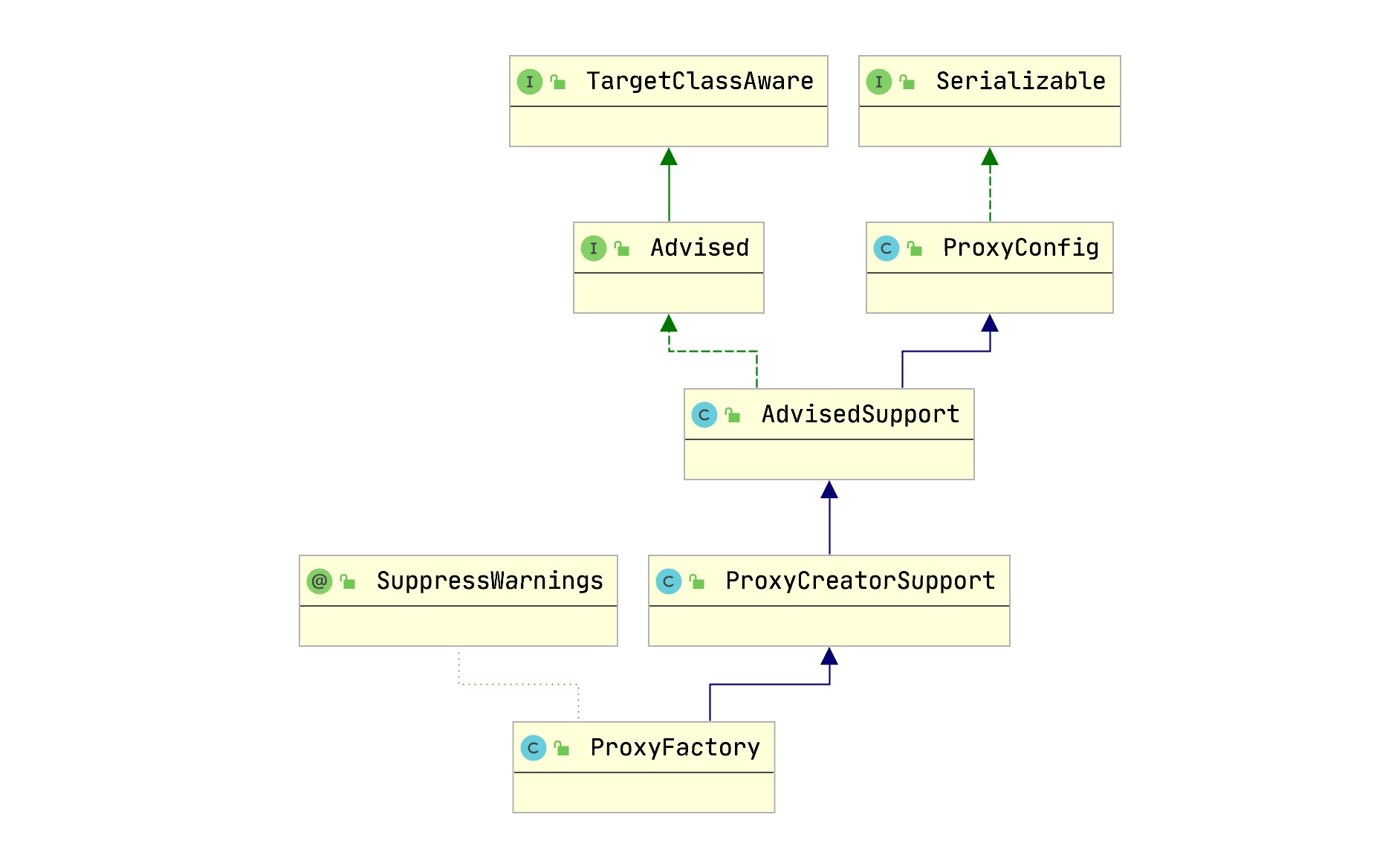
/**
* Create a new proxy according to the settings in this factory.
* <p>Can be called repeatedly. Effect will vary if we've added
* or removed interfaces. Can add and remove interceptors.
* <p>Uses the given class loader (if necessary for proxy creation).
* @param classLoader the class loader to create the proxy with
* (or {@code null} for the low-level proxy facility's default)
* @return the proxy object
*/
public Object getProxy(@Nullable ClassLoader classLoader) {
return createAopProxy().getProxy(classLoader);
}
2
3
4
5
6
7
8
9
10
11
12
# 依据条件创建代理(jdk或cglib)
DefaultAopProxyFactory.createAopProxy
@Override
public AopProxy createAopProxy(AdvisedSupport config) throws AopConfigException {
if (!NativeDetector.inNativeImage() &&
(config.isOptimize() || config.isProxyTargetClass() || hasNoUserSuppliedProxyInterfaces(config))) {
Class<?> targetClass = config.getTargetClass();
if (targetClass == null) {
throw new AopConfigException("TargetSource cannot determine target class: " +
"Either an interface or a target is required for proxy creation.");
}
if (targetClass.isInterface() || Proxy.isProxyClass(targetClass)) {
return new JdkDynamicAopProxy(config);
}
return new ObjenesisCglibAopProxy(config);
}
else {
return new JdkDynamicAopProxy(config);
}
}
2
3
4
5
6
7
8
9
10
11
12
13
14
15
16
17
18
几个要点
- config.isOptimize() 是通过optimize设置,表示配置是自定义的,默认是false;
- config.isProxyTargetClass()是通过
<aop:config proxy-target-class="true" />来配置的,表示优先使用cglib代理,默认是false; - hasNoUserSuppliedProxyInterfaces(config) 表示是否目标类实现了接口
由此我们可以知道:
Spring默认在目标类实现接口时是通过JDK代理实现的,只有非接口的是通过Cglib代理实现的。当设置proxy-target-class为true时在目标类不是接口或者代理类时优先使用cglib代理实现。
# Cglib代理实现
# 引入
我们在前文中已经介绍了SpringAOP的切面实现和创建动态代理的过程,那么动态代理是如何工作的呢?本文主要介绍Cglib动态代理的案例和SpringAOP实现的原理。
要了解动态代理是如何工作的,首先需要了解
- 什么是代理模式?
- 什么是动态代理?
- 什么是Cglib?
- SpringAOP和Cglib是什么关系?
# 动态代理要解决什么问题?
# 什么是代理?
代理模式(Proxy pattern): 为另一个对象提供一个替身或占位符以控制对这个对象的访问
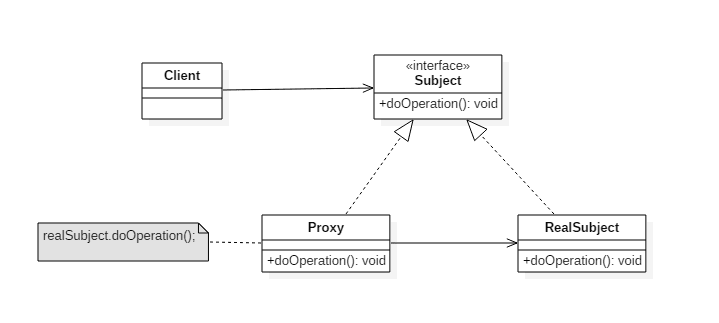
举个简单的例子:
我(client)如果要买(doOperation)房,可以找中介(proxy)买房,中介直接和卖方(target)买房。中介和卖方都实现买卖(doOperation)的操作。中介就是代理(proxy)。
# 什么是动态代理?
动态代理就是,在程序运行期,创建目标对象的代理对象,并对目标对象中的方法进行功能性增强的一种技术。
在生成代理对象的过程中,目标对象不变,代理对象中的方法是目标对象方法的增强方法。可以理解为运行期间,对象中方法的动态拦截,在拦截方法的前后执行功能操作。
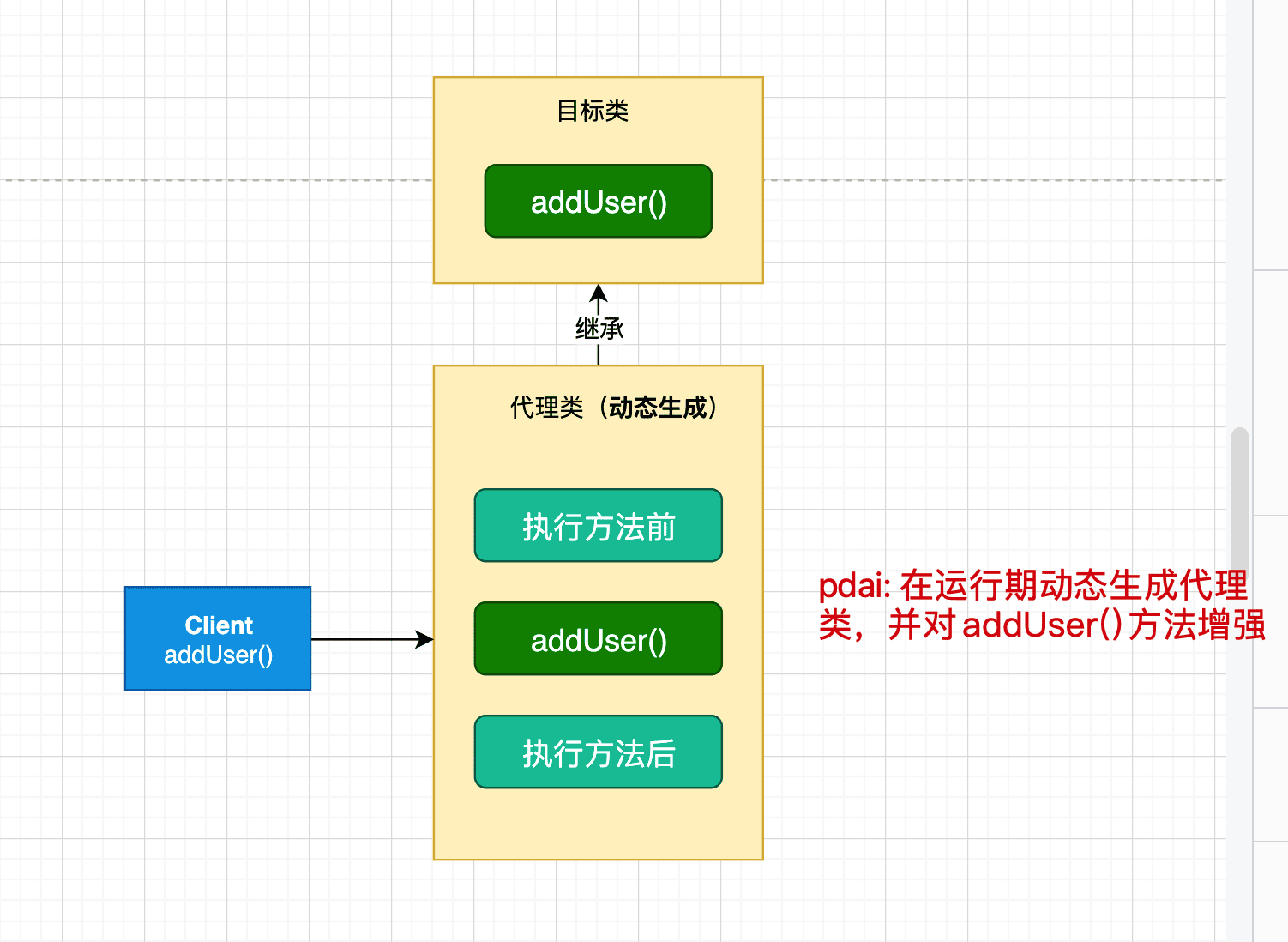
# 什么是Cglib? SpringAOP和Cglib是什么关系?
Cglib是一个强大的、高性能的代码生成包,它广泛被许多AOP框架使用,为他们提供方法的拦截。
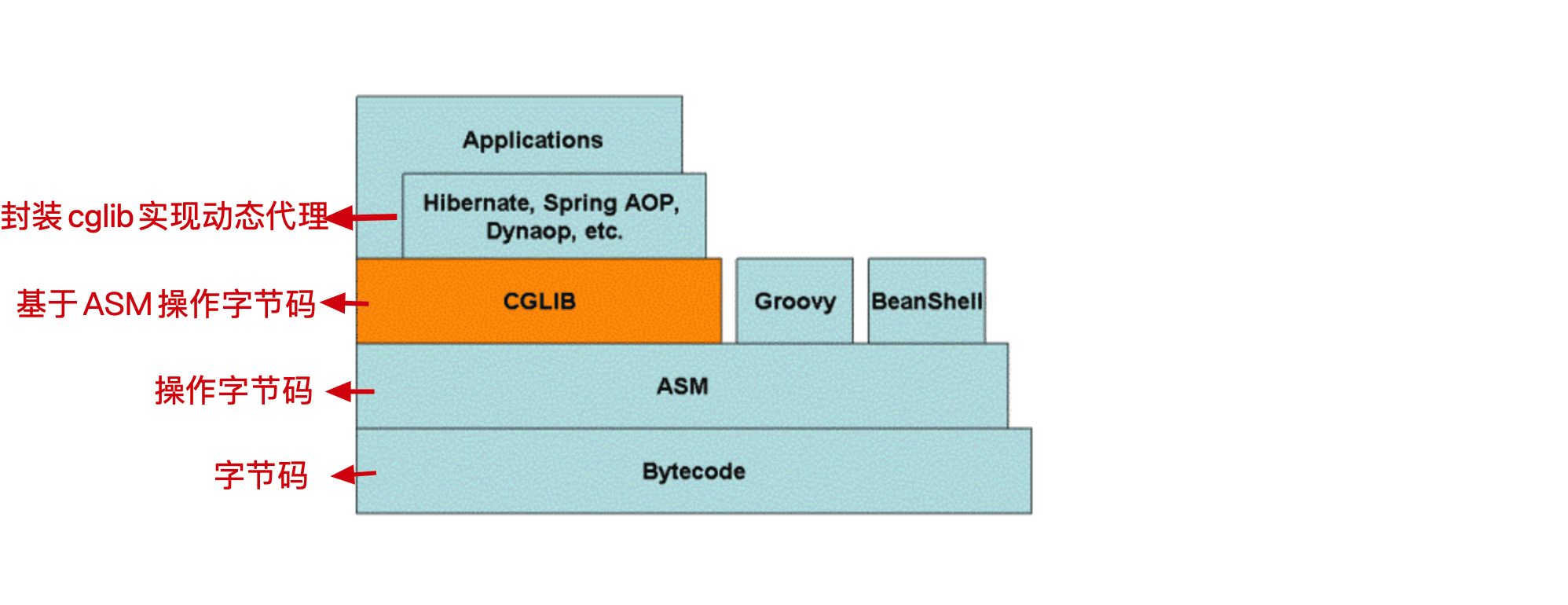
- 最底层是字节码,字节码相关的知识请参考 JVM基础 - 类字节码详解
- ASM是操作字节码的工具
- cglib基于ASM字节码工具操作字节码(即动态生成代理,对方法进行增强)
- SpringAOP基于cglib进行封装,实现cglib方式的动态代理
# Cglib代理的案例
这里我们写一个使用cglib的简单例子。@pdai
# pom包依赖
引入cglib的依赖包
<?xml version="1.0" encoding="UTF-8"?>
<project xmlns="http://maven.apache.org/POM/4.0.0"
xmlns:xsi="http://www.w3.org/2001/XMLSchema-instance"
xsi:schemaLocation="http://maven.apache.org/POM/4.0.0 http://maven.apache.org/xsd/maven-4.0.0.xsd">
<parent>
<artifactId>tech-pdai-spring-demos</artifactId>
<groupId>tech.pdai</groupId>
<version>1.0-SNAPSHOT</version>
</parent>
<modelVersion>4.0.0</modelVersion>
<artifactId>007-spring-framework-demo-aop-proxy-cglib</artifactId>
<properties>
<maven.compiler.source>8</maven.compiler.source>
<maven.compiler.target>8</maven.compiler.target>
</properties>
<dependencies>
<!-- https://mvnrepository.com/artifact/cglib/cglib -->
<dependency>
<groupId>cglib</groupId>
<artifactId>cglib</artifactId>
<version>3.3.0</version>
</dependency>
</dependencies>
</project>
2
3
4
5
6
7
8
9
10
11
12
13
14
15
16
17
18
19
20
21
22
23
24
25
26
27
28
# 定义实体
User
package tech.pdai.springframework.entity;
/**
* @author pdai
*/
public class User {
/**
* user's name.
*/
private String name;
/**
* user's age.
*/
private int age;
/**
* init.
*
* @param name name
* @param age age
*/
public User(String name, int age) {
this.name = name;
this.age = age;
}
public String getName() {
return name;
}
public void setName(String name) {
this.name = name;
}
public int getAge() {
return age;
}
public void setAge(int age) {
this.age = age;
}
@Override
public String toString() {
return "User{" +
"name='" + name + '\'' +
", age=" + age +
'}';
}
}
2
3
4
5
6
7
8
9
10
11
12
13
14
15
16
17
18
19
20
21
22
23
24
25
26
27
28
29
30
31
32
33
34
35
36
37
38
39
40
41
42
43
44
45
46
47
48
49
50
51
52
# 被代理的类
即目标类, 对被代理的类中的方法进行增强
package tech.pdai.springframework.service;
import java.util.Collections;
import java.util.List;
import tech.pdai.springframework.entity.User;
/**
* @author pdai
*/
public class UserServiceImpl {
/**
* find user list.
*
* @return user list
*/
public List<User> findUserList() {
return Collections.singletonList(new User("pdai", 18));
}
/**
* add user
*/
public void addUser() {
// do something
}
}
2
3
4
5
6
7
8
9
10
11
12
13
14
15
16
17
18
19
20
21
22
23
24
25
26
27
28
29
# cglib代理
cglib代理类,需要实现MethodInterceptor接口,并指定代理目标类target
package tech.pdai.springframework.proxy;
import java.lang.reflect.Method;
import net.sf.cglib.proxy.Enhancer;
import net.sf.cglib.proxy.MethodInterceptor;
import net.sf.cglib.proxy.MethodProxy;
/**
* This class is for proxy demo.
*
* @author pdai
*/
public class UserLogProxy implements MethodInterceptor {
/**
* 业务类对象,供代理方法中进行真正的业务方法调用
*/
private Object target;
public Object getUserLogProxy(Object target) {
//给业务对象赋值
this.target = target;
//创建加强器,用来创建动态代理类
Enhancer enhancer = new Enhancer();
//为加强器指定要代理的业务类(即:为下面生成的代理类指定父类)
enhancer.setSuperclass(this.target.getClass());
//设置回调:对于代理类上所有方法的调用,都会调用CallBack,而Callback则需要实现intercept()方法进行拦
enhancer.setCallback(this);
// 创建动态代理类对象并返回
return enhancer.create();
}
// 实现回调方法
@Override
public Object intercept(Object obj, Method method, Object[] args, MethodProxy proxy) throws Throwable {
// log - before method
System.out.println("[before] execute method: " + method.getName());
// call method
Object result = proxy.invokeSuper(obj, args);
// log - after method
System.out.println("[after] execute method: " + method.getName() + ", return value: " + result);
return null;
}
}
2
3
4
5
6
7
8
9
10
11
12
13
14
15
16
17
18
19
20
21
22
23
24
25
26
27
28
29
30
31
32
33
34
35
36
37
38
39
40
41
42
43
44
45
46
47
# 使用代理
启动类中指定代理目标并执行。
package tech.pdai.springframework;
import tech.pdai.springframework.proxy.UserLogProxy;
import tech.pdai.springframework.service.UserServiceImpl;
/**
* Cglib proxy demo.
*
* @author pdai
*/
public class ProxyDemo {
/**
* main interface.
*
* @param args args
*/
public static void main(String[] args) {
// proxy
UserServiceImpl userService = (UserServiceImpl) new UserLogProxy().getUserLogProxy(new UserServiceImpl());
// call methods
userService.findUserList();
userService.addUser();
}
}
2
3
4
5
6
7
8
9
10
11
12
13
14
15
16
17
18
19
20
21
22
23
24
25
26
# 简单测试
我们启动上述类main 函数,执行的结果如下:
[before] execute method: findUserList
[after] execute method: findUserList, return value: [User{name='pdai', age=18}]
[before] execute method: addUser
[after] execute method: addUser, return value: null
2
3
4
# Cglib代理的流程
我们把上述Demo的主要流程画出来,你便能很快理解
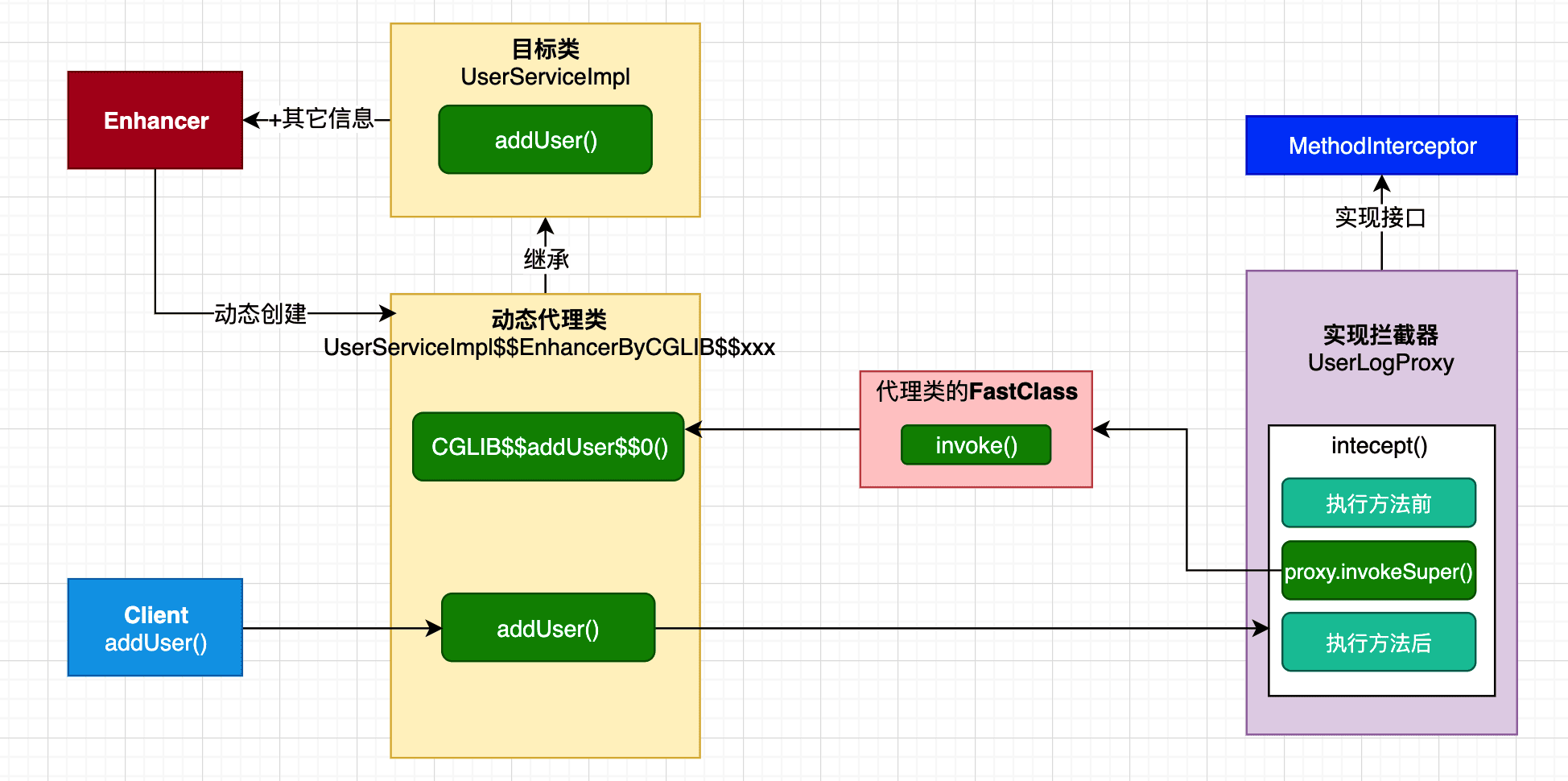
更多细节:
- 在上图中,我们可以通过在Enhancer中配置更多的参数来控制代理的行为,比如如果只希望增强这个类中的一个方法(而不是所有方法),那就增加callbackFilter来对目标类中方法进行过滤;Enhancer可以有更多的参数类配置其行为,不过我们在学习上述主要的流程就够了。
- final方法为什么不能被代理?很显然final方法没法被子类覆盖,当然不能代理了。
- Mockito为什么不能mock静态方法?因为mockito也是基于cglib动态代理来实现的,static方法也不能被子类覆盖,所以显然不能mock。但PowerMock可以mock静态方法,因为它直接在bytecode上工作,更多可以看Mockito单元测试。(pdai: 通了没?是不是so easy...)
# SpringAOP中Cglib代理的实现
SpringAOP封装了cglib,通过其进行动态代理的创建。
我们看下CglibAopProxy的getProxy方法
@Override
public Object getProxy() {
return getProxy(null);
}
@Override
public Object getProxy(@Nullable ClassLoader classLoader) {
if (logger.isTraceEnabled()) {
logger.trace("Creating CGLIB proxy: " + this.advised.getTargetSource());
}
try {
Class<?> rootClass = this.advised.getTargetClass();
Assert.state(rootClass != null, "Target class must be available for creating a CGLIB proxy");
// 上面流程图中的目标类
Class<?> proxySuperClass = rootClass;
if (rootClass.getName().contains(ClassUtils.CGLIB_CLASS_SEPARATOR)) {
proxySuperClass = rootClass.getSuperclass();
Class<?>[] additionalInterfaces = rootClass.getInterfaces();
for (Class<?> additionalInterface : additionalInterfaces) {
this.advised.addInterface(additionalInterface);
}
}
// Validate the class, writing log messages as necessary.
validateClassIfNecessary(proxySuperClass, classLoader);
// 重点看这里,就是上图的enhancer,设置各种参数来构建
Enhancer enhancer = createEnhancer();
if (classLoader != null) {
enhancer.setClassLoader(classLoader);
if (classLoader instanceof SmartClassLoader &&
((SmartClassLoader) classLoader).isClassReloadable(proxySuperClass)) {
enhancer.setUseCache(false);
}
}
enhancer.setSuperclass(proxySuperClass);
enhancer.setInterfaces(AopProxyUtils.completeProxiedInterfaces(this.advised));
enhancer.setNamingPolicy(SpringNamingPolicy.INSTANCE);
enhancer.setStrategy(new ClassLoaderAwareGeneratorStrategy(classLoader));
// 设置callback回调接口,即方法的增强点
Callback[] callbacks = getCallbacks(rootClass);
Class<?>[] types = new Class<?>[callbacks.length];
for (int x = 0; x < types.length; x++) {
types[x] = callbacks[x].getClass();
}
// 上节说到的filter
enhancer.setCallbackFilter(new ProxyCallbackFilter(
this.advised.getConfigurationOnlyCopy(), this.fixedInterceptorMap, this.fixedInterceptorOffset));
enhancer.setCallbackTypes(types);
// 重点:创建proxy和其实例
return createProxyClassAndInstance(enhancer, callbacks);
}
catch (CodeGenerationException | IllegalArgumentException ex) {
throw new AopConfigException("Could not generate CGLIB subclass of " + this.advised.getTargetClass() +
": Common causes of this problem include using a final class or a non-visible class",
ex);
}
catch (Throwable ex) {
// TargetSource.getTarget() failed
throw new AopConfigException("Unexpected AOP exception", ex);
}
}
2
3
4
5
6
7
8
9
10
11
12
13
14
15
16
17
18
19
20
21
22
23
24
25
26
27
28
29
30
31
32
33
34
35
36
37
38
39
40
41
42
43
44
45
46
47
48
49
50
51
52
53
54
55
56
57
58
59
60
61
62
63
64
65
66
获取callback的方法如下,提几个理解的要点吧,具体读者在学习的时候建议把我的例子跑一下,然后打一个断点进行理解。
rootClass: 即目标代理类advised: 包含上文中我们获取到的advisor增强器的集合exposeProxy: 在xml配置文件中配置的,背景就是如果在事务A中使用了代理,事务A调用了目标类的的方法a,在方法a中又调用目标类的方法b,方法a,b同时都是要被增强的方法,如果不配置exposeProxy属性,方法b的增强将会失效,如果配置exposeProxy,方法b在方法a的执行中也会被增强了DynamicAdvisedInterceptor: 拦截器将advised(包含上文中我们获取到的advisor增强器)构建配置的AOP的callback(第一个callback)targetInterceptor: xml配置的optimize属性使用的(第二个callback)- 最后连同其它5个默认的Interceptor 返回作为cglib的拦截器链,之后通过CallbackFilter的accpet方法返回的索引从这个集合中返回对应的拦截增强器执行增强操作。
private Callback[] getCallbacks(Class<?> rootClass) throws Exception {
// Parameters used for optimization choices...
boolean exposeProxy = this.advised.isExposeProxy();
boolean isFrozen = this.advised.isFrozen();
boolean isStatic = this.advised.getTargetSource().isStatic();
// Choose an "aop" interceptor (used for AOP calls).
Callback aopInterceptor = new DynamicAdvisedInterceptor(this.advised);
// Choose a "straight to target" interceptor. (used for calls that are
// unadvised but can return this). May be required to expose the proxy.
Callback targetInterceptor;
if (exposeProxy) {
targetInterceptor = (isStatic ?
new StaticUnadvisedExposedInterceptor(this.advised.getTargetSource().getTarget()) :
new DynamicUnadvisedExposedInterceptor(this.advised.getTargetSource()));
}
else {
targetInterceptor = (isStatic ?
new StaticUnadvisedInterceptor(this.advised.getTargetSource().getTarget()) :
new DynamicUnadvisedInterceptor(this.advised.getTargetSource()));
}
// Choose a "direct to target" dispatcher (used for
// unadvised calls to static targets that cannot return this).
Callback targetDispatcher = (isStatic ?
new StaticDispatcher(this.advised.getTargetSource().getTarget()) : new SerializableNoOp());
Callback[] mainCallbacks = new Callback[] {
aopInterceptor, //
targetInterceptor, // invoke target without considering advice, if optimized
new SerializableNoOp(), // no override for methods mapped to this
targetDispatcher, this.advisedDispatcher,
new EqualsInterceptor(this.advised),
new HashCodeInterceptor(this.advised)
};
Callback[] callbacks;
// If the target is a static one and the advice chain is frozen,
// then we can make some optimizations by sending the AOP calls
// direct to the target using the fixed chain for that method.
if (isStatic && isFrozen) {
Method[] methods = rootClass.getMethods();
Callback[] fixedCallbacks = new Callback[methods.length];
this.fixedInterceptorMap = CollectionUtils.newHashMap(methods.length);
// TODO: small memory optimization here (can skip creation for methods with no advice)
for (int x = 0; x < methods.length; x++) {
Method method = methods[x];
List<Object> chain = this.advised.getInterceptorsAndDynamicInterceptionAdvice(method, rootClass);
fixedCallbacks[x] = new FixedChainStaticTargetInterceptor(
chain, this.advised.getTargetSource().getTarget(), this.advised.getTargetClass());
this.fixedInterceptorMap.put(method, x);
}
// Now copy both the callbacks from mainCallbacks
// and fixedCallbacks into the callbacks array.
callbacks = new Callback[mainCallbacks.length + fixedCallbacks.length];
System.arraycopy(mainCallbacks, 0, callbacks, 0, mainCallbacks.length);
System.arraycopy(fixedCallbacks, 0, callbacks, mainCallbacks.length, fixedCallbacks.length);
this.fixedInterceptorOffset = mainCallbacks.length;
}
else {
callbacks = mainCallbacks;
}
return callbacks;
}
2
3
4
5
6
7
8
9
10
11
12
13
14
15
16
17
18
19
20
21
22
23
24
25
26
27
28
29
30
31
32
33
34
35
36
37
38
39
40
41
42
43
44
45
46
47
48
49
50
51
52
53
54
55
56
57
58
59
60
61
62
63
64
65
66
67
68
可以结合调试,方便理解
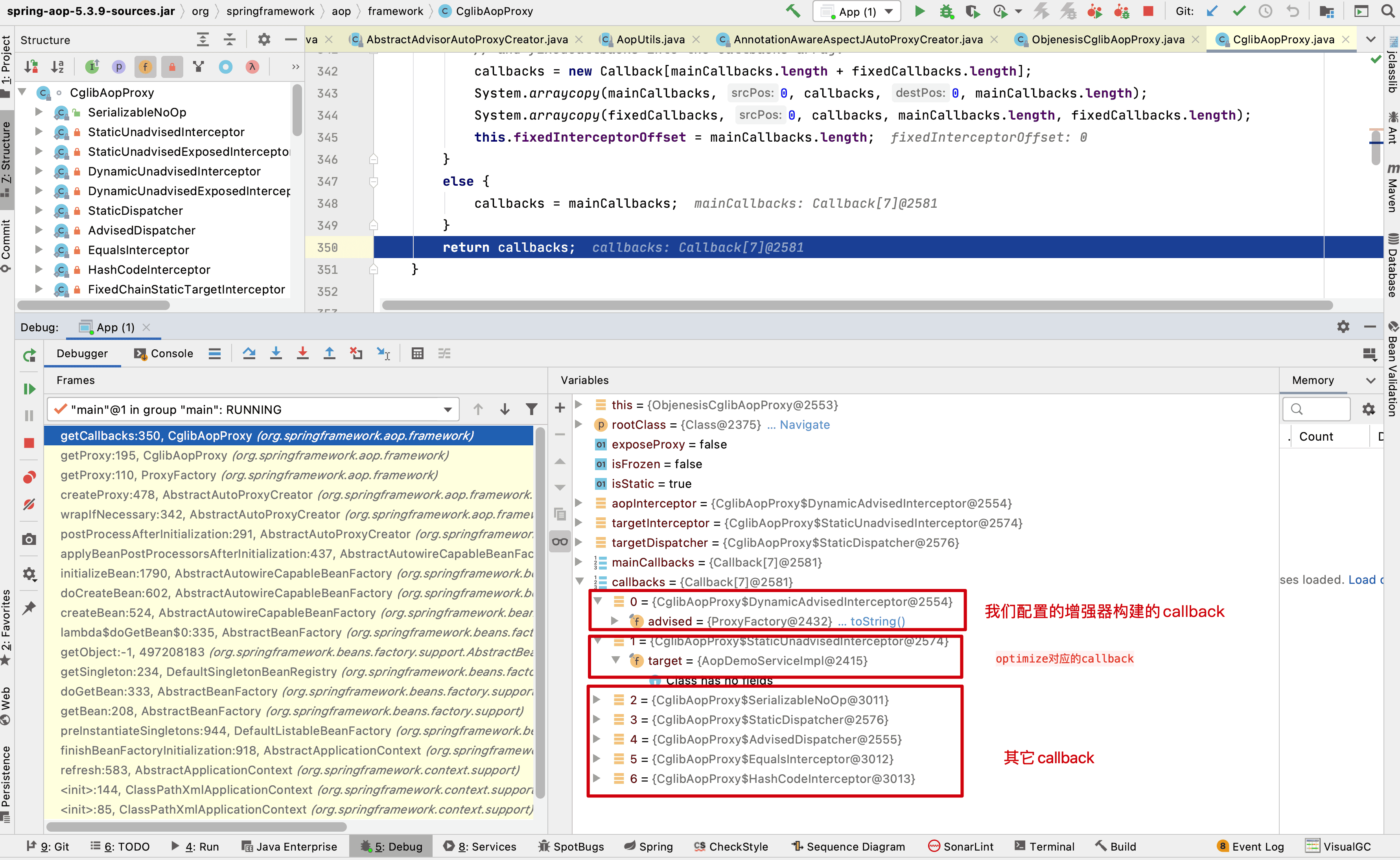
# 示例源码
https://github.com/realpdai/tech-pdai-spring-demos
# JDK代理实现
# 引入
上文我们学习了SpringAOP Cglib动态代理的实现,本文主要是SpringAOP JDK动态代理的案例和实现部分。
# 什么是JDK代理?
JDK动态代理是有JDK提供的工具类Proxy实现的,动态代理类是在运行时生成指定接口的代理类,每个代理实例(实现需要代理的接口)都有一个关联的调用处理程序对象,此对象实现了InvocationHandler,最终的业务逻辑是在InvocationHandler实现类的invoke方法上。
# JDK代理的案例
这里我们写一个使用jdk代理的简单例子。@pdai
# 不需要maven依赖
jdk代理不需要任何依赖。
<?xml version="1.0" encoding="UTF-8"?>
<project xmlns="http://maven.apache.org/POM/4.0.0"
xmlns:xsi="http://www.w3.org/2001/XMLSchema-instance"
xsi:schemaLocation="http://maven.apache.org/POM/4.0.0 http://maven.apache.org/xsd/maven-4.0.0.xsd">
<parent>
<artifactId>tech-pdai-spring-demos</artifactId>
<groupId>tech.pdai</groupId>
<version>1.0-SNAPSHOT</version>
</parent>
<modelVersion>4.0.0</modelVersion>
<artifactId>006-spring-framework-demo-aop-proxy-jdk</artifactId>
<properties>
<maven.compiler.source>8</maven.compiler.source>
<maven.compiler.target>8</maven.compiler.target>
</properties>
<!--based on jdk proxy -->
<dependencies>
</dependencies>
</project>
2
3
4
5
6
7
8
9
10
11
12
13
14
15
16
17
18
19
20
21
22
23
24
# 定义实体
User
package tech.pdai.springframework.entity;
/**
* @author pdai
*/
public class User {
/**
* user's name.
*/
private String name;
/**
* user's age.
*/
private int age;
/**
* init.
*
* @param name name
* @param age age
*/
public User(String name, int age) {
this.name = name;
this.age = age;
}
public String getName() {
return name;
}
public void setName(String name) {
this.name = name;
}
public int getAge() {
return age;
}
public void setAge(int age) {
this.age = age;
}
@Override
public String toString() {
return "User{" +
"name='" + name + '\'' +
", age=" + age +
'}';
}
}
2
3
4
5
6
7
8
9
10
11
12
13
14
15
16
17
18
19
20
21
22
23
24
25
26
27
28
29
30
31
32
33
34
35
36
37
38
39
40
41
42
43
44
45
46
47
48
49
50
51
52
# 被代理的类和接口
接口如下
package tech.pdai.springframework.service;
import tech.pdai.springframework.entity.User;
import java.util.List;
/**
* @author pdai
*/
public interface IUserService {
/**
* find user list.
*
* @return user list
*/
List<User> findUserList();
/**
* add user
*/
void addUser();
}
2
3
4
5
6
7
8
9
10
11
12
13
14
15
16
17
18
19
20
21
22
23
实现类如下:
package tech.pdai.springframework.service;
import tech.pdai.springframework.entity.User;
import java.util.Collections;
import java.util.List;
/**
* @author pdai
*/
public class UserServiceImpl implements IUserService {
/**
* find user list.
*
* @return user list
*/
@Override
public List<User> findUserList() {
return Collections.singletonList(new User("pdai", 18));
}
/**
* add user
*/
@Override
public void addUser() {
// do something
}
}
2
3
4
5
6
7
8
9
10
11
12
13
14
15
16
17
18
19
20
21
22
23
24
25
26
27
28
29
30
31
# JDK代理类
代理类如下:
package tech.pdai.springframework.proxy;
import tech.pdai.springframework.service.IUserService;
import tech.pdai.springframework.service.UserServiceImpl;
import java.lang.reflect.InvocationHandler;
import java.lang.reflect.Method;
import java.lang.reflect.Proxy;
import java.util.Arrays;
/**
* This class is for proxy demo.
*
* @author pdai
*/
public class UserLogProxy {
/**
* proxy target
*/
private IUserService target;
/**
* init.
*
* @param target target
*/
public UserLogProxy(UserServiceImpl target) {
super();
this.target = target;
}
/**
* get proxy.
*
* @return proxy target
*/
public IUserService getLoggingProxy() {
IUserService proxy;
ClassLoader loader = target.getClass().getClassLoader();
Class[] interfaces = new Class[]{IUserService.class};
InvocationHandler h = new InvocationHandler() {
/**
* proxy: 代理对象。 一般不使用该对象 method: 正在被调用的方法 args: 调用方法传入的参数
*/
@Override
public Object invoke(Object proxy, Method method, Object[] args) throws Throwable {
String methodName = method.getName();
// log - before method
System.out.println("[before] execute method: " + methodName);
// call method
Object result = null;
try {
// 前置通知
result = method.invoke(target, args);
// 返回通知, 可以访问到方法的返回值
} catch (NullPointerException e) {
e.printStackTrace();
// 异常通知, 可以访问到方法出现的异常
}
// 后置通知. 因为方法可以能会出异常, 所以访问不到方法的返回值
// log - after method
System.out.println("[after] execute method: " + methodName + ", return value: " + result);
return result;
}
};
/**
* loader: 代理对象使用的类加载器.
* interfaces: 指定代理对象的类型. 即代理代理对象中可以有哪些方法.
* h: 当具体调用代理对象的方法时, 应该如何进行响应, 实际上就是调用 InvocationHandler 的 invoke 方法
*/
proxy = (IUserService) Proxy.newProxyInstance(loader, interfaces, h);
return proxy;
}
}
2
3
4
5
6
7
8
9
10
11
12
13
14
15
16
17
18
19
20
21
22
23
24
25
26
27
28
29
30
31
32
33
34
35
36
37
38
39
40
41
42
43
44
45
46
47
48
49
50
51
52
53
54
55
56
57
58
59
60
61
62
63
64
65
66
67
68
69
70
71
72
73
74
75
76
77
78
# 使用代理
启动类中指定代理目标并执行。
package tech.pdai.springframework;
import tech.pdai.springframework.proxy.UserLogProxy;
import tech.pdai.springframework.service.IUserService;
import tech.pdai.springframework.service.UserServiceImpl;
/**
* Jdk proxy demo.
*
* @author pdai
*/
public class ProxyDemo {
/**
* main interface.
*
* @param args args
*/
public static void main(String[] args) {
// proxy
IUserService userService = new UserLogProxy(new UserServiceImpl()).getLoggingProxy();
// call methods
userService.findUserList();
userService.addUser();
}
}
2
3
4
5
6
7
8
9
10
11
12
13
14
15
16
17
18
19
20
21
22
23
24
25
26
27
# 简单测试
我们启动上述类main 函数,执行的结果如下:
[before] execute method: findUserList
[after] execute method: findUserList, return value: [User{name='pdai', age=18}]
[before] execute method: addUser
[after] execute method: addUser, return value: null
2
3
4
# JDK代理的流程
JDK代理自动生成的class是由sun.misc.ProxyGenerator来生成的。
# ProxyGenerator生成代码
我们看下sun.misc.ProxyGenerator生成代码的逻辑:
/**
* Generate a proxy class given a name and a list of proxy interfaces.
*
* @param name the class name of the proxy class
* @param interfaces proxy interfaces
* @param accessFlags access flags of the proxy class
*/
public static byte[] generateProxyClass(final String name,
Class<?>[] interfaces,
int accessFlags)
{
ProxyGenerator gen = new ProxyGenerator(name, interfaces, accessFlags);
final byte[] classFile = gen.generateClassFile();
...
}
2
3
4
5
6
7
8
9
10
11
12
13
14
15
generateClassFile方法如下:
/**
* Generate a class file for the proxy class. This method drives the
* class file generation process.
*/
private byte[] generateClassFile() {
/* 第一步:将所有方法包装成ProxyMethod对象 */
// 将Object类中hashCode、equals、toString方法包装成ProxyMethod对象
addProxyMethod(hashCodeMethod, Object.class);
addProxyMethod(equalsMethod, Object.class);
addProxyMethod(toStringMethod, Object.class);
// 将代理类接口方法包装成ProxyMethod对象
for (Class<?> intf : interfaces) {
for (Method m : intf.getMethods()) {
addProxyMethod(m, intf);
}
}
// 校验返回类型
for (List<ProxyMethod> sigmethods : proxyMethods.values()) {
checkReturnTypes(sigmethods);
}
/* 第二步:为代理类组装字段,构造函数,方法,static初始化块等 */
try {
// 添加构造函数,参数是InvocationHandler
methods.add(generateConstructor());
// 代理方法
for (List<ProxyMethod> sigmethods : proxyMethods.values()) {
for (ProxyMethod pm : sigmethods) {
// 字段
fields.add(new FieldInfo(pm.methodFieldName,
"Ljava/lang/reflect/Method;",
ACC_PRIVATE | ACC_STATIC));
// 上述ProxyMethod中的方法
methods.add(pm.generateMethod());
}
}
// static初始化块
methods.add(generateStaticInitializer());
} catch (IOException e) {
throw new InternalError("unexpected I/O Exception", e);
}
if (methods.size() > 65535) {
throw new IllegalArgumentException("method limit exceeded");
}
if (fields.size() > 65535) {
throw new IllegalArgumentException("field limit exceeded");
}
/* 第三步:写入class文件 */
/*
* Make sure that constant pool indexes are reserved for the
* following items before starting to write the final class file.
*/
cp.getClass(dotToSlash(className));
cp.getClass(superclassName);
for (Class<?> intf: interfaces) {
cp.getClass(dotToSlash(intf.getName()));
}
/*
* Disallow new constant pool additions beyond this point, since
* we are about to write the final constant pool table.
*/
cp.setReadOnly();
ByteArrayOutputStream bout = new ByteArrayOutputStream();
DataOutputStream dout = new DataOutputStream(bout);
try {
/*
* Write all the items of the "ClassFile" structure.
* See JVMS section 4.1.
*/
// u4 magic;
dout.writeInt(0xCAFEBABE);
// u2 minor_version;
dout.writeShort(CLASSFILE_MINOR_VERSION);
// u2 major_version;
dout.writeShort(CLASSFILE_MAJOR_VERSION);
cp.write(dout); // (write constant pool)
// u2 access_flags;
dout.writeShort(accessFlags);
// u2 this_class;
dout.writeShort(cp.getClass(dotToSlash(className)));
// u2 super_class;
dout.writeShort(cp.getClass(superclassName));
// u2 interfaces_count;
dout.writeShort(interfaces.length);
// u2 interfaces[interfaces_count];
for (Class<?> intf : interfaces) {
dout.writeShort(cp.getClass(
dotToSlash(intf.getName())));
}
// u2 fields_count;
dout.writeShort(fields.size());
// field_info fields[fields_count];
for (FieldInfo f : fields) {
f.write(dout);
}
// u2 methods_count;
dout.writeShort(methods.size());
// method_info methods[methods_count];
for (MethodInfo m : methods) {
m.write(dout);
}
// u2 attributes_count;
dout.writeShort(0); // (no ClassFile attributes for proxy classes)
} catch (IOException e) {
throw new InternalError("unexpected I/O Exception", e);
}
return bout.toByteArray();
}
2
3
4
5
6
7
8
9
10
11
12
13
14
15
16
17
18
19
20
21
22
23
24
25
26
27
28
29
30
31
32
33
34
35
36
37
38
39
40
41
42
43
44
45
46
47
48
49
50
51
52
53
54
55
56
57
58
59
60
61
62
63
64
65
66
67
68
69
70
71
72
73
74
75
76
77
78
79
80
81
82
83
84
85
86
87
88
89
90
91
92
93
94
95
96
97
98
99
100
101
102
103
104
105
106
107
108
109
110
111
112
113
114
115
116
117
118
119
120
121
122
123
124
125
126
127
128
129
130
131
一共三个步骤(把大象装进冰箱分几步?):
- 第一步:(把冰箱门打开)准备工作,将所有方法包装成ProxyMethod对象,包括Object类中hashCode、equals、toString方法,以及被代理的接口中的方法
- 第二步:(把大象装进去)为代理类组装字段,构造函数,方法,static初始化块等
- 第三步:(把冰箱门带上)写入class文件
# 从生成的Proxy代码看执行流程
从上述sun.misc.ProxyGenerator类中可以看到,这个类里面有一个配置参数sun.misc.ProxyGenerator.saveGeneratedFiles,可以通过这个参数将生成的Proxy类保存在本地,比如设置为true 执行后,生成的文件如下:
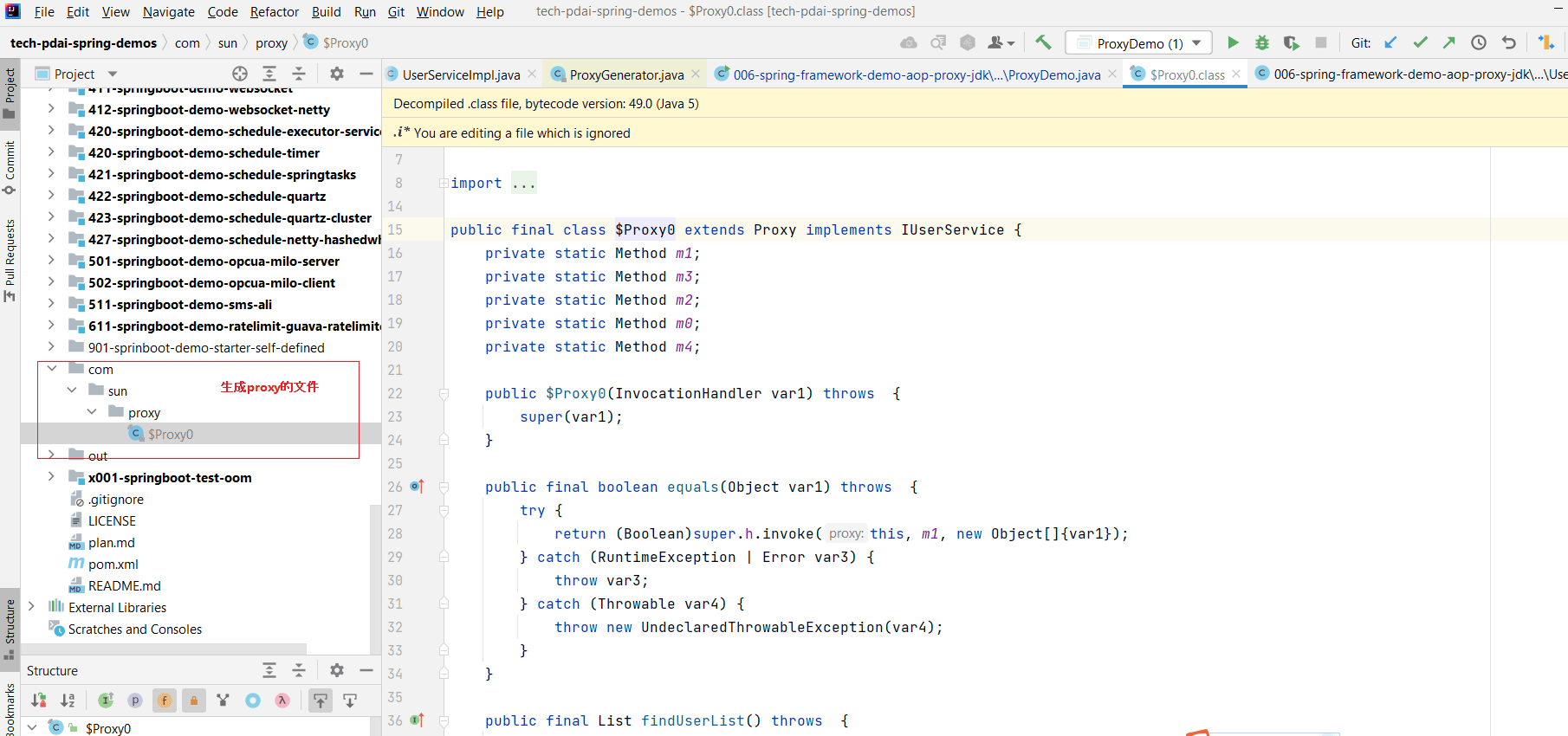
我们看下生成后的代码:
//
// Source code recreated from a .class file by IntelliJ IDEA
// (powered by FernFlower decompiler)
//
package com.sun.proxy;
import java.lang.reflect.InvocationHandler;
import java.lang.reflect.Method;
import java.lang.reflect.Proxy;
import java.lang.reflect.UndeclaredThrowableException;
import java.util.List;
import tech.pdai.springframework.service.IUserService;
// 所有类和方法都是final类型的
public final class $Proxy0 extends Proxy implements IUserService {
private static Method m1;
private static Method m3;
private static Method m2;
private static Method m0;
private static Method m4;
// 构造函数注入 InvocationHandler
public $Proxy0(InvocationHandler var1) throws {
super(var1);
}
public final boolean equals(Object var1) throws {
try {
return (Boolean)super.h.invoke(this, m1, new Object[]{var1});
} catch (RuntimeException | Error var3) {
throw var3;
} catch (Throwable var4) {
throw new UndeclaredThrowableException(var4);
}
}
public final List findUserList() throws {
try {
return (List)super.h.invoke(this, m3, (Object[])null);
} catch (RuntimeException | Error var2) {
throw var2;
} catch (Throwable var3) {
throw new UndeclaredThrowableException(var3);
}
}
public final String toString() throws {
try {
return (String)super.h.invoke(this, m2, (Object[])null);
} catch (RuntimeException | Error var2) {
throw var2;
} catch (Throwable var3) {
throw new UndeclaredThrowableException(var3);
}
}
public final int hashCode() throws {
try {
return (Integer)super.h.invoke(this, m0, (Object[])null);
} catch (RuntimeException | Error var2) {
throw var2;
} catch (Throwable var3) {
throw new UndeclaredThrowableException(var3);
}
}
public final void addUser() throws {
try {
super.h.invoke(this, m4, (Object[])null);
} catch (RuntimeException | Error var2) {
throw var2;
} catch (Throwable var3) {
throw new UndeclaredThrowableException(var3);
}
}
static {
try {
// 初始化 methods, 2个IUserService接口中的方法,3个Object中的接口
m1 = Class.forName("java.lang.Object").getMethod("equals", Class.forName("java.lang.Object"));
m3 = Class.forName("tech.pdai.springframework.service.IUserService").getMethod("findUserList");
m2 = Class.forName("java.lang.Object").getMethod("toString");
m0 = Class.forName("java.lang.Object").getMethod("hashCode");
m4 = Class.forName("tech.pdai.springframework.service.IUserService").getMethod("addUser");
} catch (NoSuchMethodException var2) {
throw new NoSuchMethodError(var2.getMessage());
} catch (ClassNotFoundException var3) {
throw new NoClassDefFoundError(var3.getMessage());
}
}
}
2
3
4
5
6
7
8
9
10
11
12
13
14
15
16
17
18
19
20
21
22
23
24
25
26
27
28
29
30
31
32
33
34
35
36
37
38
39
40
41
42
43
44
45
46
47
48
49
50
51
52
53
54
55
56
57
58
59
60
61
62
63
64
65
66
67
68
69
70
71
72
73
74
75
76
77
78
79
80
81
82
83
84
85
86
87
88
89
90
91
92
上述代码是比较容易理解的,我就不画图了。
主要流程是:
- ProxyGenerator创建Proxy的具体类$Proxy0
- 由static初始化块初始化接口方法:2个IUserService接口中的方法,3个Object中的接口方法
- 由构造函数注入InvocationHandler
- 执行的时候,通过ProxyGenerator创建的Proxy,调用InvocationHandler的invoke方法,执行我们自定义的invoke方法
# SpringAOP中JDK代理的实现
SpringAOP扮演的是JDK代理的创建和调用两个角色,我们通过这两个方向来看下SpringAOP的代码(JdkDynamicAopProxy类)
# SpringAOP Jdk代理的创建
代理的创建比较简单,调用getProxy方法,然后直接调用JDK中Proxy.newProxyInstance()方法将classloader和被代理的接口方法传入即可。
@Override
public Object getProxy() {
return getProxy(ClassUtils.getDefaultClassLoader());
}
@Override
public Object getProxy(@Nullable ClassLoader classLoader) {
if (logger.isTraceEnabled()) {
logger.trace("Creating JDK dynamic proxy: " + this.advised.getTargetSource());
}
return Proxy.newProxyInstance(classLoader, this.proxiedInterfaces, this);
}
2
3
4
5
6
7
8
9
10
11
12
# SpringAOP Jdk代理的执行
执行的方法如下:
/**
* Implementation of {@code InvocationHandler.invoke}.
* <p>Callers will see exactly the exception thrown by the target,
* unless a hook method throws an exception.
*/
@Override
@Nullable
public Object invoke(Object proxy, Method method, Object[] args) throws Throwable {
Object oldProxy = null;
boolean setProxyContext = false;
TargetSource targetSource = this.advised.targetSource;
Object target = null;
try {
// 执行的是equal方法
if (!this.equalsDefined && AopUtils.isEqualsMethod(method)) {
// The target does not implement the equals(Object) method itself.
return equals(args[0]);
}
// 执行的是hashcode方法
else if (!this.hashCodeDefined && AopUtils.isHashCodeMethod(method)) {
// The target does not implement the hashCode() method itself.
return hashCode();
}
// 如果是包装类,则dispatch to proxy config
else if (method.getDeclaringClass() == DecoratingProxy.class) {
// There is only getDecoratedClass() declared -> dispatch to proxy config.
return AopProxyUtils.ultimateTargetClass(this.advised);
}
// 用反射方式来执行切点
else if (!this.advised.opaque && method.getDeclaringClass().isInterface() &&
method.getDeclaringClass().isAssignableFrom(Advised.class)) {
// Service invocations on ProxyConfig with the proxy config...
return AopUtils.invokeJoinpointUsingReflection(this.advised, method, args);
}
Object retVal;
if (this.advised.exposeProxy) {
// Make invocation available if necessary.
oldProxy = AopContext.setCurrentProxy(proxy);
setProxyContext = true;
}
// Get as late as possible to minimize the time we "own" the target,
// in case it comes from a pool.
target = targetSource.getTarget();
Class<?> targetClass = (target != null ? target.getClass() : null);
// 获取拦截链
List<Object> chain = this.advised.getInterceptorsAndDynamicInterceptionAdvice(method, targetClass);
// Check whether we have any advice. If we don't, we can fallback on direct
// reflective invocation of the target, and avoid creating a MethodInvocation.
if (chain.isEmpty()) {
// We can skip creating a MethodInvocation: just invoke the target directly
// Note that the final invoker must be an InvokerInterceptor so we know it does
// nothing but a reflective operation on the target, and no hot swapping or fancy proxying.
Object[] argsToUse = AopProxyUtils.adaptArgumentsIfNecessary(method, args);
retVal = AopUtils.invokeJoinpointUsingReflection(target, method, argsToUse);
}
else {
// We need to create a method invocation...
MethodInvocation invocation =
new ReflectiveMethodInvocation(proxy, target, method, args, targetClass, chain);
// Proceed to the joinpoint through the interceptor chain.
retVal = invocation.proceed();
}
// Massage return value if necessary.
Class<?> returnType = method.getReturnType();
if (retVal != null && retVal == target &&
returnType != Object.class && returnType.isInstance(proxy) &&
!RawTargetAccess.class.isAssignableFrom(method.getDeclaringClass())) {
// Special case: it returned "this" and the return type of the method
// is type-compatible. Note that we can't help if the target sets
// a reference to itself in another returned object.
retVal = proxy;
}
else if (retVal == null && returnType != Void.TYPE && returnType.isPrimitive()) {
throw new AopInvocationException(
"Null return value from advice does not match primitive return type for: " + method);
}
return retVal;
}
finally {
if (target != null && !targetSource.isStatic()) {
// Must have come from TargetSource.
targetSource.releaseTarget(target);
}
if (setProxyContext) {
// Restore old proxy.
AopContext.setCurrentProxy(oldProxy);
}
}
}
2
3
4
5
6
7
8
9
10
11
12
13
14
15
16
17
18
19
20
21
22
23
24
25
26
27
28
29
30
31
32
33
34
35
36
37
38
39
40
41
42
43
44
45
46
47
48
49
50
51
52
53
54
55
56
57
58
59
60
61
62
63
64
65
66
67
68
69
70
71
72
73
74
75
76
77
78
79
80
81
82
83
84
85
86
87
88
89
90
91
92
93
94
95
96
97
著作权归@pdai所有 原文链接:
- https://pdai.tech/md/spring/spring-x-framework-aop-source-2.html
- https://pdai.tech/md/spring/spring-x-framework-aop-source-3.html
- https://pdai.tech/md/spring/spring-x-framework-aop-source-4.html
